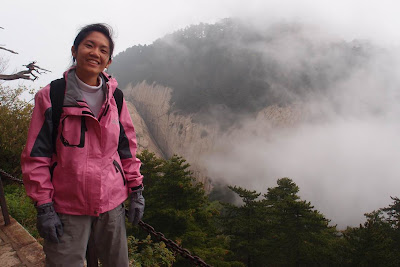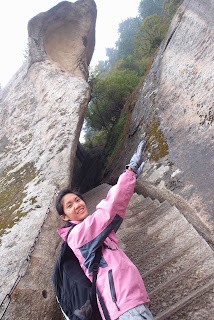
We went there in a mini-van together with 3 other backpackers we met along the way.
One of them, a university student on holiday, was really good at bargaining. She arranged the transport.
The driver quoted RMB100 for a 2-way trip to the national park.
Initially, she was alone, she asked could she pay RMB70 instead? Driver said ok.
Then we called her and said we would be joining her.
Uni Student: Now there's 3 people going.
Driver: Ok, RMB100 in total.
Uni Student: But you can't divide RMB100 by 3. We'll pay you RMB90.
Driver: Ok.
Then we found another couple to join us.
Uni Student: There's 2 more people. So that'll be RMB90 for 5 people... ok?
Driver: ... ok...
The highest point in the park is at 4600m.
You can buy oxygen spray cans at the entrance. Visitors who feel unwell due to the high altitude can breathe in some oxygen every 15min or so.
I did feel breathless when we reached 3500m.
It was very strange, I was panting as if I had just climbed 10 flights of stairs, but I wasn't doing anything, I was just sitting in the bus.
The feeling didn't last long though, after I got off the bus and got some fresh air, I felt alright again.
The driver told us we'd probably spend about 2-3 hours there. The longest that any group he brought stayed for 5 hours. We beat the record and spent 7 hours there!
The 7 hours were spent hiking (environmentally-friendly electric buses took us to the boardwalks, all grassland was out of bounds) and taking photos.
There was a flower (can't remember its name) that we saw everywhere.
We saw the white ones and pink ones, but very few red ones.
We should have been seeing more red flowers (it was late May then), but because of the cold spell this year, the red flowers bloomed only later.
Other flora we saw:
 |
| Tiny blue flowers in the grass |
 |
| Conifer. Looks like a curious fly peeping out from a leafy wreath. |
 |
| Conifers |
 |
| You can find a fuzzy aerial plant hanging on many of the fir trees. We were told this aerial plant can only survive in the most unpolluted environments. |

We met with all sorts of weather while there:
 |
| Rainy weather |
 |
| Windy weather |
 |
| Cloudy weather |
 | |
| Hearts in the sky weather |
 |
| Yaks |
 |
| More yaks |
 |
| Squirrels |
 |
| More squirrels |
We found a new way of filming Bollywood movies - hiding inside instead of behind trees :)
Some of the other nicer photos we took.
(With 480 photos, there'd better be some nice ones!)
 |
| Fallen tree |
The heavens declare the glory of God; and the firmament sheweth his handywork.
Psalm 19:1
God's creations are truly beautiful!
For the beauty of the earth,
For the glory of the skies;
For the love which from our birth,
Over and around us lies;
Lord of all, to Thee we raise
This, our hymn of grateful praise.
For the wonder of each hour,
Of the day and of the night;
Hill and vale and tree and flow'r,
Sun and moon, and stars of light;
Lord of all, to Thee we raise
This, our hymn of grateful praise.



































